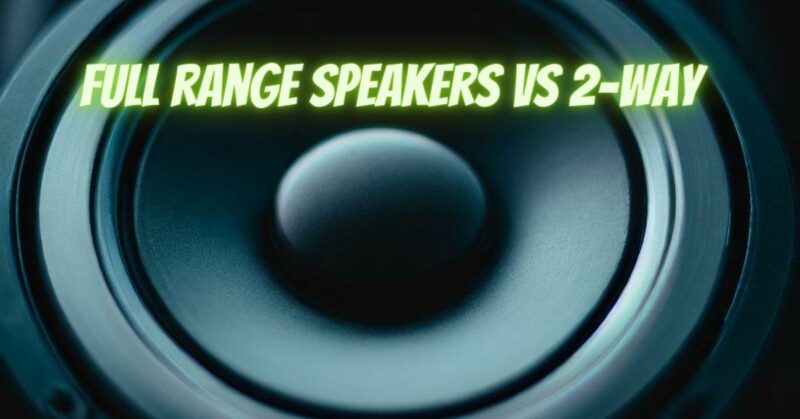When it comes to speaker configurations, two common options you’ll come across are full range speakers and 2-way speakers. Each design has its own characteristics and advantages, which can significantly impact audio performance. In this article, we’ll explore the differences between full range speakers and 2-way speakers to help you make an informed decision when choosing speakers for your audio setup.
- Design and Speaker Components:
Full Range Speakers: Full range speakers are designed to reproduce the entire audio frequency range, from low to high frequencies, using a single driver. These speakers usually consist of a woofer or mid-range driver that handles both bass and mid-range frequencies, and sometimes a smaller tweeter for high-frequency reproduction. The single driver design simplifies the speaker’s construction and can provide a coherent and balanced sound across the frequency spectrum.
2-Way Speakers: 2-Way speakers, as the name suggests, utilize two dedicated drivers for audio reproduction. They typically consist of a woofer or mid-range driver for handling bass and mid-range frequencies, combined with a separate tweeter for high-frequency reproduction. The division of frequencies between the drivers allows for more specialized performance in their respective frequency ranges.
- Frequency Response and Sound Reproduction:
Full Range Speakers: Full range speakers aim to provide a comprehensive frequency response, covering a wide range of frequencies. While they can reproduce the entire frequency spectrum, the trade-off is that the individual drivers may not excel in specific frequency ranges. This can result in limitations in terms of extreme bass depth or high-frequency extension, but they can still offer balanced and coherent sound reproduction.
2-Way Speakers: With dedicated drivers for different frequency ranges, 2-way speakers can provide more optimized performance. The woofer or mid-range driver focuses on delivering accurate and detailed mid-range and bass frequencies, while the dedicated tweeter handles high frequencies with greater precision and clarity. This specialization allows for more refined sound reproduction, especially in the respective frequency ranges assigned to each driver.
- Speaker Size and Placement Considerations:
Full Range Speakers: Full range speakers are often available in various sizes, ranging from compact bookshelf models to floor-standing towers. The size and design of the speaker can impact its bass extension and overall soundstage. Smaller full range speakers may have limitations in reproducing deep bass, while larger floor-standing models can offer more expansive sound and improved low-frequency response. Proper speaker placement and room acoustics should be considered to optimize the performance of full range speakers.
2-Way Speakers: Similar to full range speakers, 2-way speakers are available in different sizes and form factors. The size of the woofer or mid-range driver can influence bass performance and overall output capabilities. Compact 2-way bookshelf speakers may excel in near-field listening environments, while larger floor-standing models can provide deeper bass and more dynamic sound for larger rooms or home theater setups.
| feature | Full Range Speakers | 2-Way Speakers |
|---|---|---|
| Frequency range | 20 Hz to 20 kHz | 20 Hz to 20 kHz |
| Drivers | One | Two |
| Woofer size | Typically 4 inches to 8 inches in diameter | Typically 4 inches to 6 inches in diameter |
| Tweeter size | Typically 1 inch to 2 inches in diameter | Typically 1 inch to 1.5 inches in diameter |
| Power output | Typically 10 to 100 watts | Typically 10 to 50 watts |
| Purpose | To reproduce a wide range of frequencies | To reproduce a wide range of frequencies, with better separation of low and high frequencies |


